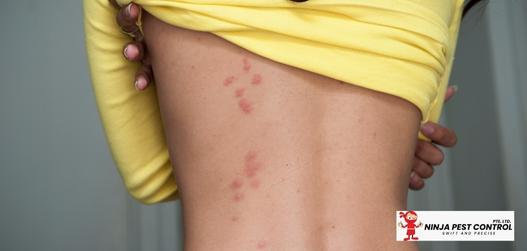All About Bed Bug Bites
Pest Control > Bed Bugs Control > Do Bed Bugs Fly?
Although the typical bed bug, commonly known as Cimex lectularius primarily feeds on people, it will also bite other warm-blooded animals including dogs, cats, birds, and mice.
Bedbugs do not spread any diseases, but their bites might be unpleasant and itchy.
Bed bugs frequently leave small, red, raised pimples on the skin. They are most commonly observed in a tiny area, which may be itchy or unpleasant.
Blood stains on one’s bed sheets, bites, and the presence of bed bug feces and cast skins are all signs that a bed bug infestation may be present.
Why Do Bed Bugs Bite?
Bed bugs are sucking parasites that require blood for sustenance and one bed bug usually would take more than one bite and would even consume the blood of several people.
Once a bed bug has inserted its mouthparts into the skin and discovered a viable blood vessel, it will begin feeding. Finding the appropriate blood vessel might take more than one injection into the skin.
Bed bugs are extremely sensitive to movements by the host on which they are feeding. As a result, if a sleeping person moves about, a feeding bed bug will most likely withdraw its mouthparts and begin seeking for a blood meal on another area of the body.
Where Are Bed Bug Bites Normally Found?
Bites are most likely on the hands, neck, face, shoulders, legs, and arms since these areas are more often exposed to bed bugs during sleep.
What Do The Bites Look Like?
Bites look like tiny, flat, or elevated patches that might become inflamed, itchy, red, or painful.
Bites from bed bugs are often grouped together in a limited region, and they sometimes appear in a line or zigzag formation.
How Much Blood Can Bed Bugs Consume?
A bed bug can consume up to six times its own weight in blood during one feeding frenzy, which lasts between three to ten minutes.
Are Bed Bugs Bites Painful?
Bed bugs have elongated beaks that they use to pierce human skin and suck blood. Bed bug bites are not always painful at first and can go unnoticed for hours or days. This allows bed bugs to consume human blood for up to 10 minutes during each feeding by puncturing vulnerable areas of the body, such as the upper torso, neck, and shoulders.
What Happens When Bed Bugs Bite Our Skin?
Bed bugs pierce the skin of their host with their saliva and injected an anticoagulant. The anti-coagulant is mostly to blame for how a person responds to the bite and, as a result, what size the bug’s bite appears. Because people will have various degrees of sensitivity to the bed bug’s bite.
What Affects The Size of The Bite
Other than how one’s skin respond to the anticoagulant, the number of times someone is bitten also has an impact on the size of a bed bug reaction. People who have been bit many times may react in various ways, and their response may be either greater or less powerful as the total number of bites rises.
Bed Bug Bites Reaction
Bed bug bites don’t always produce symptoms right away and can take a few days to begin. However, not everyone reacts to bed bug bites in the same way.
Individuals bitten by bed bugs may experience itching, red welts, or swelling the day after being bitten. Bites can not be felt on some persons for a number of days or even more. Many individuals are unaffected by the bite of a bed bug—many bites go unnoticed because they leave no mark.
A mild burning sensation may be felt at first. The painful region soon develops red bumps, known as papules or wheals (rash). Bites can occasionally raise dramatically in size or transform into blister-like skin inflammations in severe circumstances.
Bed Bug Bites Risks
Many individuals report severe itching, which can be treated with an anti-itch cream. Bed bug bites should always be cleaned and disinfected as soon as possible to avoid secondary infections that may cause further swelling and bleeding.
Secondary infections from bed bug bites are common in children, the elderly, and persons with compromised immune systems, particularly those who are bedridden.
If you get a rash after being bitten by a bed bug, don’t scratch the affected region. If the rash persists or becomes inflamed, see a medical expert right now.
Bed Bug Bites on Pets
Bites on dogs and cats will seem much the same as those on people, and the pet’s owner may believe a mosquito or flea caused the injury.
The feces, cast skins, and animal discomfort at night are all signs that bed bugs are biting pets. As a result, one of the most effective measures is to examine the pet’s bedding and groom it frequently while also looking for telltale indications of bed bug presence.
All in all, bed bug bites on pets are not a major health concern, though they can be a nuisance. If you think your pet has been bitten by bed bugs, take some time to inspect its bedding and contact a pest control Singapore professional that offers professional bed bugs control in Singapore if necessary.
500+
Homes Inspected
300+
Successful Projects Executed
4-5 Stars
Positive Ratings

